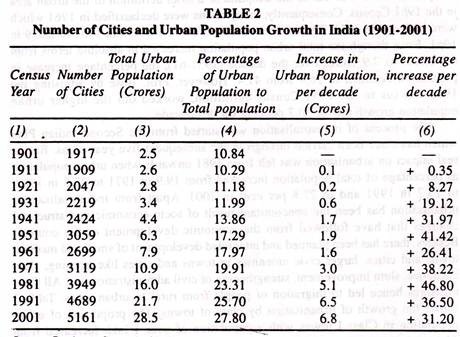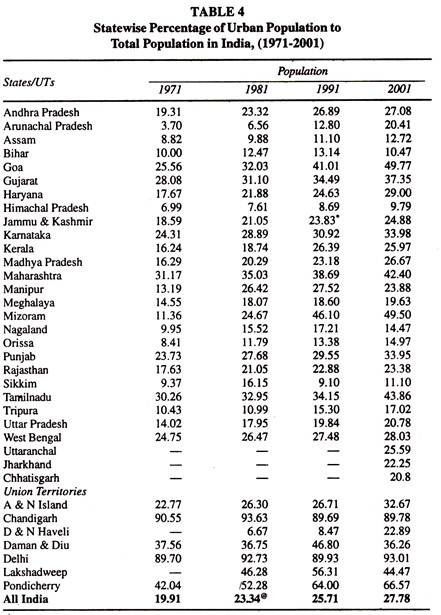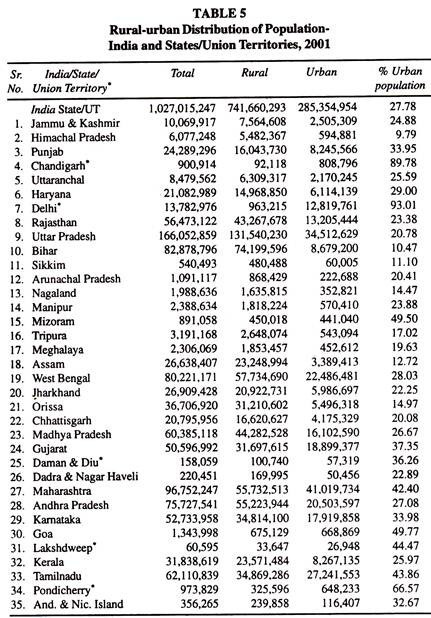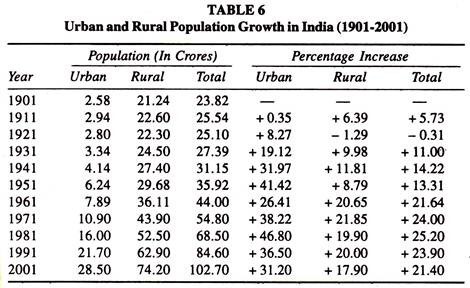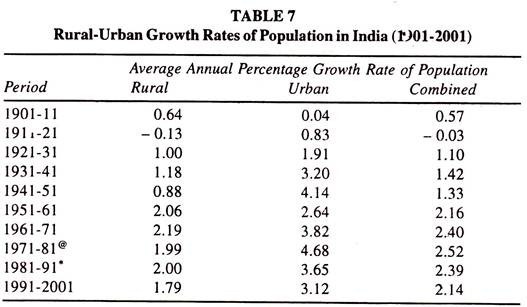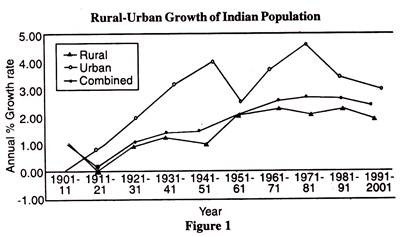Read this essay to learn about Urbanisation in India. After reading this essay you will learn about:- 1. Introduction to Urbanisation 2. Methods of Measuring the Extent of Urbanisation 3. Factors Responsible 4. Inter-State Variation 5. Rural-Urban Population Growth in India 6. Problems 7. Measures to Solve the Problems 8. Appraisal.
Essay Contents:
- Essay on the Introduction to Urbanisation
- Essay on the Methods of Measuring the Extent of Urbanisation
- Essay on the Factors Responsible for Urbanisation in India
- Essay on the Inter-State Variation in Urbanisation
- Essay on the Rural-Urban Population Growth in India
- Essay on the Problems of Urbanisation
- Essay on the Measures to Solve the Problems of Urbanisation
- Essay on the Appraisal of Urbanisation in India
1. Essay on the Introduction to Urbanisation:
According to Pravin Visaria, “The level of urbanisation in the country is substantially affected by the specific definitions chosen by the national authorities.” In keeping with this, there was no specific definition of urban area in India till 1941.
Accordingly, all towns were included in urban areas in the various censuses. So with the increase in number of towns, the urban population showed a rising trend. The number of cities increased from 1,917 in 1901 to 5,161 in 2001. Correspondingly, urban population as percentage of total population of the country increased from 10.8 per cent in 1901 to 27.8 per cent in 2001.
The growth of urban population as percentage of total population was very slow from 1901 to 1931. It was 10.8 per cent in 1901 which rose to 12 per cent in 1931 (Table 2). In fact, urban population declined to 10.3 per cent in 1911 due to high death rate in towns and the migration of people to rural areas with the spread of plague.
Even though there was a decline in the population growth of India by (-) 0.3 per cent during the decade of 1911-21, urban population increased by 8.3 per cent.
This was due to the migration of population to urban areas near port cities and development of industrial towns. This trend continued during the decade of 1921-31 when urban population increased by 19 per cent.
During 1931-41, there was a rapid growth of urban population by about 32 per cent. There was the Great Depression in 1930s which led to sharp fall in the prices of agricultural goods and raw materials. This forced farmers to leave villages and migrate to towns in search of jobs.
Thereafter started the Second World War in 1939 which revived the economy. Industrial development to meet domestic demand and war supplies attracted large numbers to urban areas. People also migrated to towns and cities attracted by the new life styles.
During the decade 1941-51, there was a phenomenal increase in urban population by 41.4 per cent. This was due to the continuation of the momentum of war time industrial development and the migration of about 3 million persons to urban areas after the Partition of 1947. The sharp increase in urban growth of population during this decade was due to the very liberal definition of the urban area adopted in 1951. So this much increase in 1951 was statistical.
But in the next decade 1951-61, there was a sharp decline in the urban growth rate of population from 41.4 per cent to 26.4 per cent. According to Ashish Bose, this phenomenon was due to the adoption of a strict definition of the urban area in the 1961 Census. Consequently, many towns were declassified in 1961 which were included in 1951.
The number of towns fell from 3,059 in 1951 to 2,699 in 1961. Even though the total urban population increased in absolute terms from 6.3 crores to 7.9 crores over the decade (1951-61), the percentage increase in population declined to 26.4 from 41.4. However, Prof. Bose by adjusting the 1961 Census to the 1951 Census definition, worked out the higher urban population growth rate of 30.7 per cent for this decade.
The process of industrialisation was started from the Second Indian Plan which has since been carried through in the subsequent five year plans. But its real impact on urbanisation was felt from 1981 onwards when urban population as percentage of total population increased from 19.9 in 1971 to 23.3 in 1981, to 25.7 in 1991 and to 27.8 per cent in 2001.
Apart from industrialisation, urbanisation has been the concomitant result of socio-economic and structural changes that have followed from the economic development of the country. Besides, there has been planned and integrated development of small and medium towns and cities, larger civic amenities in towns and cities like housing, slum clearance, slum improvement, strengthening of civil administration, etc.
All these measures hence led to migration of people from rural to urban areas. Table 3 shows the growth of urbanisation by class of towns. The proportion of urban population in Class I towns with a population of over 1 lakh increased from 44.6 per cent in 1951 to 65.2 per cent in 1991.
But there has been little change in the relative proportion of urban population in Class II towns. The percentage of population remained between 10 to 11 per cent during 1951-91 in them.
The table reveals that the percentage of population in Class III to Class IV towns from 15.8 per cent to 13.2per cent and 20.9 per cent to 7.8 per cent respectively during this period. Besides, the number of Class V and Class VI towns declined from 1124 in 1951 to 725 in 1991 and from 569 in 1951 to 185 in 1991 respectively along with the percentage of population in them.
These figures show that population migrated from small towns to big cities of Class I and II.
With liberalisation of the Indian economy particularly during the last decade, there has been widespread expansion of consumer goods, and educational facilities in marketing, management, finance, banking, insurance, information technology, etc. which have attracted people to towns and cities for training and employment.
There has also been marked changes in the landscapes of towns and cities where high-rise buildings, entertainment centres, shopping malls are fast coming up.
They are changing the life-styles of the urbanities. All these are acting as pull factors to urban areas. As opposed to this, the majority of rural areas even after 50 years of planned economic development lack in basic services like access to safe drinking water, sanitation facilities, employment opportunities, educational, medical, and infrastructural facilities, etc. These act as push factors to urban areas.
2. Essay on the Methods of Measuring the Extent of Urbanisation:
The pace, extent and process of urbanisation can be measured with the help of the following four methods:
(i) Percentage Size of Total Population in Urban Areas:
This is the easiest method of measuring urbanisation.
According to this method, the percentage of total population living in cities can be measured with the following formula:
Where PU = Percentage of urban population; U – Urban population, and P = Total population of the country.
According to the 1971 Census of India,
Urban Population =10,90,94,309
Total population of the country = 54,81,59,652
Thus , the percentage of the urban population in India= x 100
= 19.90 per cent
The merit of this method of measuring the size of urban population is that it is easy to estimate and interpret it. The statistical information is obtained easily. But the usefulness of this method is limited for understanding the historical trends or international comparisons. This is because the definition of urban areas is different in different countries. It is different at different times even in the same country. Moreover, it cannot be known from this formula the percentage of population in cities of different sizes.
According to Eduardo Arriaga, if we have to make a meaningful comparison then people living in different sizes of cities should be taken rather than of people living in urban areas.
For instance, in the 1991 Census of India, urbanisation had been shown by the following class of towns as shown in Table 1 below:
Ist: population of 1 lakh and above;
IInd: population between 50,000 and 99,999;
IIIrd: population between 20,000 and 49,999;
IVth: population between 10,000 and 19,999;
Vth: population between 5,000 and 9,999; and
Vlth: population below 5,000.
This classification is better because it tells us not only about the size of population in towns but also the percentage total urban population living there.
(ii) Multiplier of Urban-Rural Population:
This method shows that how many persons live in every urban area per rural person.
This can be measured by the following formula:
Where, UR = Urban-rural multiplier; U – Urban population; and R = Rural Population.
According to the 1971 Census of India, the size of urban population was 10,90,94,309, while the size of rural population was 43,90,65,343. Thus the size of urban population per rural person was 0.248 which shows that the size of urban population was less.
This formula is influenced by the definition of urban areas in relation to percentage of urban population. It is a useful method for rural-urban comparisons which also shows the rate of urbanisation.
(iii) Size of Place of People Living in Median Location:
This method is the same as the mean age. The mean age of the population shows the age above the centre or below the centre in which the registration of all the people is done in minimum to maximum or from maximum to minimum due to which half the population is shown below the mid-population and half the population is shown above the mid-population.
In this way, the total population is divided into equal values from the view point of age. In the same way, people living in the average
Where, Ml = People living in median location, PPi = Population lower than 50 per cent of the cumulative population of a place, PPi + 1 = Percentage of population of place of second level size, Qi =Upper limit of size of i place, and Qi + 1 = Upper limit of size of i + 1 place.
According to this formula, as the size of place of people living in median location increases, the size of urbanisation also increases. According to this formula, the size of urbanisation can only be measured when more than 50 per cent of the total population of the country lives in the cities.
(iv) Pace of Urbanisation:
According to this method, the size of urbanisation is measured on the basis of the absolute changes in the percentage size or through percentage change in the urban population size during two points of time. For measuring the annual growth rate of urbanisation, the method of calculating the annual growth rate of population of a country can be used.
For this, many assumptions are to be made regarding changes in the rate of population growth, how changes take place and the type of changes.
3. Factors Responsible for Urbanisation in India:
The following are the causes of urbanisation which relate to countries like India:
(i) Population Increase:
The natural increase in population is a major factor in urbanisation. In India, there is a steady increase in the size of urban centres as well as the level of urbanization. Between 1951 and 1991, urban population increased more than three times. It was 62.4 million in 1951 which increased to 217.2 million in 1991.
(ii) Industrialisation:
When the process of industrialization increases, economic development take places and modern sectors like trade, commerce, transport and its allied services also develop. This results in rural-urban migration, because the workforce migrates from agriculture to non-agricultural sectors.
Sometimes due to economic development, rural areas turn into towns or urban areas and the surplus population in agricultural sector moves to urban areas. Thus industrialization is an important factor for urbanization.
(iii) Specialisation in Occupations:
Another factor responsible for urbanization is specialisation. This being an age of specialisation, people try to specialise in diverse occupations relating to trade, commerce, industries and services. So they migrate to urban areas for education, training and for jobs. This leads to urbanisation.
(iv) Political Factors:
Political factors are also responsible for urbanization. Since ancient times the capital city of a country urbanizes faster. Generally, the capital city is a place where all Government offices, industrial houses, educational institutions, foreign embassies, etc. are located.
(v) Growth Sectors:
The growth centres of the economy such as manufacturing and services are usually located near cities where they benefit from the flow of inputs, outputs and labour from far and near. This leads to urbanisation of villages, and small towns in the vicinity of such centres.
(vi) Location of Mineral Deposits:
Generally, the location of coal and iron mines accelerates the process of urban expansion as it induces the location of coal and iron based industries in a particular centre. Jamshedpur, in India, is an example of this type of urbanisation. Also the location of steel plants of the public sector is responsible for the growth of urban centres like Bhilai, Rourkela and Durgapur.
(vii) Port Towns:
Port towns also turn into big urban centres in the course of time because trading and industrial activities are agglomerated in such centres. The entire import-export trade is conducted from that centre. Along with the growth of trading and industrial activities, business offices, banking institutions, insurance companies get agglomerated in a port town.
The result is that a small town becomes a larger urban centre. Cities like Mumbai, Chennai and Kolkata are the living examples of this type of urban centres.
(viii) Religious Factors:
Since ancient times religious factors have also been responsible for urbanisation. Location of temples in many cities turn into urban centres in course of time. Thus the places of worship like Shree Nathdwara, Amritsar, Varanasi, Allahabad, Nasik, Rameshwaram, etc. have turned into big urban centres in the course of time.
(ix) Educational and Cultural Centres:
The places where the various educational institutions like schools, colleges and universities are located turn into big urban centres. Since ancient times, educational centres like Varanasi, Takshila, Mumbai, Chennai and Kolkata have turned into big urban centres which in turn, induce further growth of urban centres.
Side by side, trading and industrial activities agglomerate and urban centres grow. Such urban centres also develop into cultural centres which attract people from other areas.
(x) Transport and Communication Facilities:
Cheap and easy availability of transport and communications has been a responsible factor for urban expansion. Growth of cities like Mumbai, Delhi, Kolkata and Chennai are the examples where cheap transportation facilities have been an important factor. Similarly, modern communication facilities also help the process of urban expansion which, in turn, induce the growth of trading and industrial activities.
(xi) Migration:
The migration from rural areas also leads to urbanisation. This is due to several factors mentioned above such as industrialisation, receiving education in cities, seeking jobs, etc.
(xii) Boundary Changes:
At times, boundaries of towns are extended. Rural areas are included in urban areas. The satellite towns are included in urban or metropolitan centres as has been done in the case of Delhi. Sometimes, migration of population due to the partition of the country leads to urbanisation on a large scale, as happened after the Partition of India in 1947.
4. Essay on the Inter-State Variation in Urbanisation:
Table 4 shows wide variations in urban population from State to State in India. The table shows that out of all the States and Union Territories, Delhi, the National Capital Territory, is the most urbanized with 93 per cent (128 lakh) urban population. Delhi is followed by the Union Territory of Chandigarh with 89.8 per cent (8.09 lakh), and Pondicherry with 66.6 per cent (6.48 lakh) urban population.
Among the major States, the most urbanized State is Tamil Nadu in which 43.9 per cent (272 lakh) population is living in urban areas. Tamil Nadu is followed by Maharashtra with 42.4 per cent (410 lakh) and Gujarat with 37.4 per cent (189 lakh) population living in urban areas.
Bihar is the only State where urban population is the lowest. In Bihar only 10.5 per (86 lakh) population is recorded in urban areas, followed by Assam with 12.7 per cent (34 lakh) and Orissa with 14.9 per cent (54 lakh) population living in urban areas. Besides, among all the States and Union Territories, Himachal Pradesh is the least urbanized State with 9.8 per cent (6 lakh) urban population as per the Census of 2001.
In the Census of 2001, if the total number of persons living in urban areas in absolute terms is taken, Maharashtra led with the highest urban population of 410 lakh which was 14 per cent of the total urban population of the country, while in Uttar Pradesh there were 346 lakh persons living in urban areas, as shown in Table 5.
5. Essay on the Rural-Urban Population Growth in India:
Table 6 shows that as on 1 March, 2001, the total population of India was 102.70 crore, out of which 74.2 crore lived in rural areas and 28.5 crore in urban areas. During 1991-2001, the net addition of population in rural areas was 11.3 crore while in urban areas, it was 6.8 crore. During the decade, the growth of population in rural areas was 17.9 percent while in urban areas it was 31.2 percent.
In the 1991 Census, the percentage of urban population to total population was 25.7 which stood at 27.8 per cent in the 2001 Census. This shows that during 1991-2001, there has been an increase of 2.1 percentage in the proportion of urban population in India.
Table 7 and figure 1 depict the difference between rural and urban growth rates of population from 1901 to 2001. It reveals that after the decade of 1911, the rate of urban population growth remained higher than the rate of rural population growth. During ten census periods from 1911 to 2001, the average rate of urban population growth in each decade had remained 28 per cent.
Besides, the annual percentage growth rate of population in India from 1901 to 2001, the average annual percentage growth rate of rural population was the highest, 2.19 per cent during the decade 1961-71, while that of urban growth was the highest, 4.68 percent during 1971-81. In the following two decades of 1981-91 and 1991- 2001 the growth rate of urban population was much higher than the rural population. This reveals the impact of industrialisation programmes.
6. Essay on the Problems of Urbanisation:
The problems of urbanisation can be classified into economic, social, infrastructural and administrative.
We discuss them as under:
(i) Economic Problems:
The main economic problems of urbanisation are the lack of basic services in cities.
They are the result of rapid growth of population leading to:
(i) growth of huge slums and shanty towns lacking in clean drinking water and no access to the simplest latrines;
(ii) growth of city limits leading to overcrowding in other residential areas thereby creating problems of residential accommodation, electricity, water supply, drainage, collection of social wastes which pile up on streets and drains leading to flooding, and garbage overall insanitary conditions in the city;
(iii) release of domestic and industrial effluents into waterways without any treatment leading to the pollution of drinking water;
(iv) air pollution due to heavy traffic on the streets and roads, and water pollution adversely affect human health and lead to air-borne and water-borne diseases. Besides, those living in slums and near industrial sites are exposed to indoor air pollution from badly ventilated cooking facilities within the living room;
(v) growth of unemployment problem due to increase in the growth rate of the urban population as a consequent of the failure of the urban formal and informal sectors to absorb additions to the labour force;
(vi) increase in urban poverty and inequality of incomes due to the lack of basic facilities, and growing unemployment and underemployment of the rising labour force; and
(vii) shortages of schools, colleges, dispensaries, hospitals, means of transport, housing, etc. leading to overcrowding.
(ii) Social Problems:
Urbanisation breeds many complex social problems. It destroys the values, culture and conventions of the society. Shortage of living space and high cost of living leads to the breakup of the joint family system. It leads to crimes, violence, juvenile delinquency, drug addiction, alcoholism, depression, suicidal tendencies, restlessness in educational institutions, social unrest, prostitution, etc.
(iii) Infrastructural Problems:
Infrastructure refers to the existence of basic facilities and services which are essential for the operation and development of other sectors of the economy and improving the quality of life of the people. With urbanisation and growth of cities, infrastructural problems arise in the form of shortages of electric power; kerosene, coal and gas for cooking; petrol for running transport services; school, college and other educational buildings; roads, buses, tramways, railways, flyovers, waterways, bridges; sewerage system, houses, administrative buildings, etc.
The government and local bodies are unable to find sufficient financial resources to meet them in comparison to their ever- increasing demand.
(iv) Administrative Problems:
With the growth of urban centres and cities, many administrative problems crop up. They include controlling crime, violence, traffic, protecting life and property, establishing civil protection system, etc. Consequently, the pressure on administration and police force increases. There are always shortages of administrative and police personnel due to ever-growing size of the cities.
7. Measures to Solve Problems of Urbanisation:
The following measures are suggested to solve the problems of urbanisation:
1. Population growth in urban areas should be controlled and brought down. The need is to reduce the birth rate especially among the urban poor. So far as the death rate is concerned, it is being cut down with improvement in health services even in slums.
2. In the majority of developing countries like India, the public sector owns and controls urban areas. The local bodies or municipal corporations should provide such services as water supply, sewerage, sanitation and management of solid and liquid waste, electricity, gas, etc.
3. There is greater need for infrastructural development in urban areas in order to remove crowding and pollution. Besides the public authorities, private enterprise should be permitted to undertake widening of roads; constructing flyovers, bridges and new roads; plying of city buses and other means of transport; new houses for low income and middle income groups; one-room tenements for slum dwellers; parks; entertainment centres and parks; buildings for schools, colleges and other educational and training institutes, etc.
4. Though controlling crime and violence is the responsibility of city police and administration, residents can protect their properties by establishing civil protection systems in their respective areas by pooling resources under the guidance of administration.
5. To reduce congestion and overcrowding, there should be dispersal of industries by establishing new industrial centres and towns in the periphery of the metropolis. But it is imperative that all urban facilities are provided there.
6. Above all, to reduce migration to towns and cities, living conditions in villages should be improved by providing drinking water, electricity, medical, health and education facilities. It is also imperative to create larger employment opportunities in villages by setting up ancillary, food processing and other industries.
Besides, a good network of transport and communication system should be laid for the movement of labour, farm produce and industrial raw materials from rural to urban areas. All these measures will help in developing rural areas and prevent people from settling permanently in urban areas.
8. An Appraisal of Urbanisation in India:
Urbanisation is a natural consequence of economic development of a country. It is characterised by the movement of an increasing proportion of population from rural to urban areas. Urbanisation is a product of industrialisation. Urban population in India as the percentage of total population has been on the increase since 1971 with industrialisation. It rose from 19.9 per cent in 1971 to 27.8 per cent in 2001.
Besides, urbanisation has helped to contribute to the development process in a number of ways. This is reflected in the increasing contribution of the urban sector to India’s GDP. In 1950-51, its contribution to India’s GDP was only 29 per cent which has risen to 50 per cent at present.
Urbanisation has led to decline in birth rate and a shift towards the small family. It has led to an increasing division of labour, growing specialisation and shift of many activities from non- market oriented vocations within the family or the village to specialised market- oriented firms.
It has brought people together from different rural areas who have learnt from each other and those already living in towns. It has facilitated the development of impersonal relations of modern life and taught cooperation and brought cultural unity among the urbanities. By creating educational and technical institutions, it has helped in increasing knowledge.
But the ongoing development process is expected to further increase the growth of urban population in India, as is evident from the Population Projections given in Table 10. It is projected to grow from 2.9 lakh in 2001 to 4.2 lakh in 2016. This will lead to more deterioration in the physical environment and quality of life in urban areas.
There is already a wide gap between demand and supply of essential services and infrastructure in urban areas which is bound to increase further.
For instance, the demand for basic services like supply of drinking water, sanitation, housing, transport, etc. has outstripped their availability. Urban life has become costlier because of congestion and overcrowding. Consequently, consumer expenditure on different types of consumer goods has increased, especially due to the demonstration effect of the city life.
The remedy lies in providing basic urban services and development of infrastructural facilities. So far urban development policies have been related to solving such problems as housing, slum clearance, improvement and upgradation, development of small and medium towns, strengthening of municipal civil administration, etc. But these policies are not likely to succeed because of the increasing trend of urbanisation in the country.
With paucity of funds with the State governments and local bodies, there is need to encourage private sector for infrastructure and housing development. Public sector should act in cooperation with the private sector. There is also the need to bring about rural- urban cohesion.
This can be achieved through the process of spatial planning based on the concept of “growth centres”. They will attract private investments in developing such centres with all basic and infrastructural facilities. This policy will reduce the pressure on towns and cities and create “nuclei of development”.
